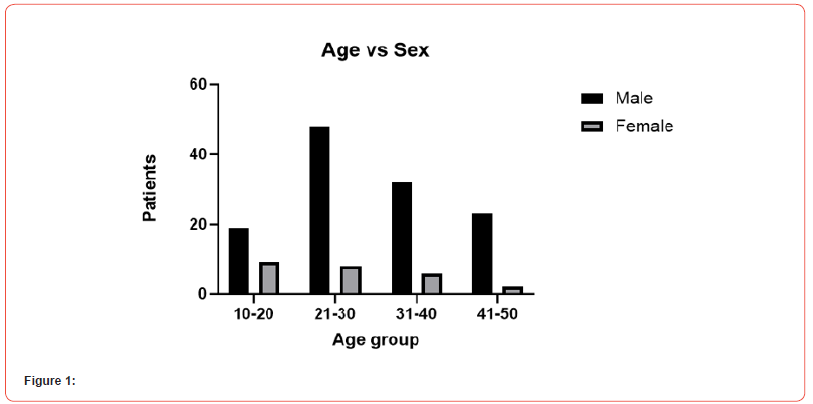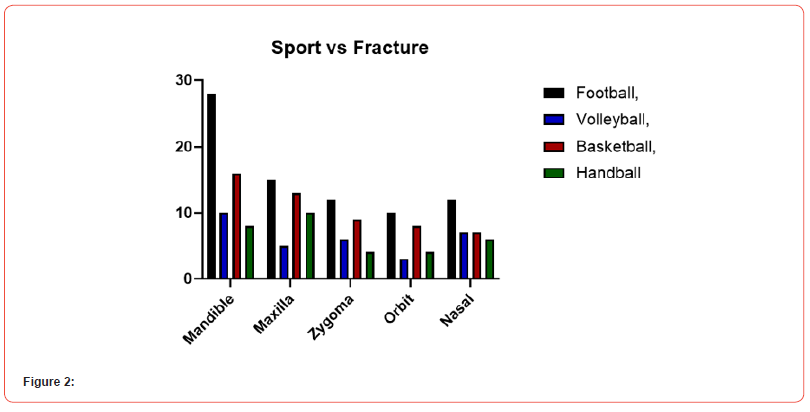 Research Article
Research Article
Prevalence Of Maxillofacial Bone Fractures in Team Sports Ball in North of Jordan
Ahmed S B Bataineh1 and Anwar B Bataineh2*
1Professor of Biomechanics in Sport, Faculty of Physical Education, Yarmouk University, Irbid, Jordan
2Professor of Oral & Maxillofacial Surgery, Faculty of Dentistry, Jordan University of Science & Technology, Irbid, Jordan
Anwar B Bataineh, Professor of Oral & Maxillofacial Surgery, Faculty of Dentistry, Jordan University of Science & Technology, Irbid, Jordan.
Received Date:January 22, 2024; Published Date:January 30, 2024
Background: Team sports ball is a popular sport played as competitive or recreational leagues; maxillofacial fractures are a known problem
occurring from games.
Purpose: The aim of this study was to investigate the prevalence of sports-related maxillofacial injuries in team sports in Jordan.
Methods: This was a retrospective cohort study of clinical records and radiographs of patients treated with sports-related maxillofacial
bone fractures during a 4-year period. The data were derived from an extensive review of medical records of specific kinds of ball sports Football,
Volleyball, Basketball, and Handball, were retrieved and analyzed for age, sex, incident anatomical location of affected maxillofacial bone fracture.
Categorical data were presented as frequency and percentages using a chi-square test of independence for independent samples with a p value ≤0.05
considered significance.
Results: A total of 193 maxillofacial fractures were documented in 147 patients in this study. The patients ranged in age from 10 to 50 years
old with a mean age was 26.13 years old. Of these, males were 90(80.36%) and females were 22(19.64%), the male to female ratio was 4.88:1.
The highest incidence was observed in the 21- 30 years old age group with 48 (39.35%) in male patients. The most common fractures were in the
mandible in 62 (32.12%) patients, followed by maxilla in 43(22.28%) patients. The maxillofacial fractures occurred most frequently while playing
football in 77 (39.90%)
Conclusion: The present review offered an updated understanding of the aspects of the epidemiology of sports injuries, such as age range,
gender, and type of sport-related maxillofacial Fractures.
Keywords:Trauma; Mandible; Fracture; Etiology; Epidemiological; Treatment
Introduction
Trauma starts with the transfer of energy to the body from an outside force. The transfer of kinetic energy may be blunt or sharp in nature. Maxillofacial bone trauma is often encountered in sports, and sports etiology is one of the most common causes of maxillofacial injuries [1]. A collision, fall, or being struck with a ball is usually the mechanism of injury for facial fractures [2]. A body in motion remains in motion until acted upon by an outside force. Velocity of the load applied determines damage (force = mass x acceleration). Tissue is displaced in the direction of the moving object. If an object is deformable, the time to impact is increased and thus the damage is increased. Kinetic energy transferred is additive if both objects moving (½ mass x velocity2) [3]. Ball sports is a popular sport in Jordan; however, serious maxillofacial injuries can be sustained as part of the team sports: football, basketball, volleyball, handball, with rare cases even leading to death. A 12-year-old Michigan girl who was struck in the head by a ball while practicing with her team sustained a serious brain injury that led to her death a day later [4]. Many elements of softball play involve high-energy events that can cause head and facial injuries, including pitching, batting, or running into other players or objects. For example, batted balls include energy from the original pitch as well as the swung bat [5]. Epidemiological studies are also valuable in identifying new frequencies and patterns of these fractures. Sporting activities can be grouped into different categories in order to understand better the injury mechanism in sports related facial bone fractures: such as team sports: football, basketball, volleyball, handball. The aim of this study was to investigate the prevalence of sports-related maxillofacial injuries in team sports in Jordan.
Material and Methods
This was a retrospective cohort study of clinical records and radiographs of patients with sports-related maxillofacial bone fractures treated in the Departments of Oral and Maxillofacial Surgery of four hospitals in northern part of Jordan. During the 4-year period from January 2018 to December 2021. The data were derived from an extensive review of medical records and were retrieved and analyzed. Data fields included age, sex, kind of team sport, anatomical location of bone was classified into mandible, maxilla, zygoma, orbit and nasal bone fracture and kinds of team ball sports were football, volleyball, basketball, and handball.
This ethical approval and the informed consent form was waived by the regional Institutional Review Board (IRB) of Jordan University of Science and Technology due to the retrospective nature of this study. The medical research protocol adopted in this study followed the Declaration of Helsinki. Inclusion criteria were patients aged 10 to 50 years at time of presentation and injury occurred between January 2018, and December 2021. Exclusion criteria were patients who did not meet these criteria were excluded from the study. Categorical data were presented as significant percentages using a chi-square test of independence for independent samples with a p value ≤0.05 was considered significant.
Results
A total of 193 maxillofacial fractures were documented in 147 patients in this study with a mean of 1.3 fractures for each patient. The patients ranged in age from 10 to 50 years old with mean age was 26.13 years old and SD age, 26.54 ± 11.56 years old, demographic variables of maxillofacial fractures in team sports (Table 1). 122(84.14%) of injured players were male, while 25(15.86%) were female, the male to female ratio was 4.9:1. The highest incidence was observed in the 21- 30 years old age group with 48 (39.35%) in male patients (Table 2), (Figure 1). The most common fractures were in the mandible in 62 (32.12%) patients, followed by maxilla in 43(22.28%) patients. The maxillofacial fractures occurred most frequently while playing football in 77 (39.90%), followed by basketball 53 (27.5%), distribution anatomical location of maxillofacial fractures according to kinds of ball sports shown in (Table 3), (Figure 2).
Table 1:Demographic Variables of maxillofacial fractures.

Table 2:Distribution of age of maxillofacial fractures according to sex.

Table 3:Distribution Anatomical location of maxillofacial fractures according to kinds of ball sports.

Figure 1:

Figure 2:

Discussion
The specific studies cited measured the incidence rate of maxillofacial injuries by site, sport, and gender were as inspiration for this study to investigate the incidence rate of maxillofacial injuries by age, sex, kind of team sport and anatomical location of bone. It is important to better understand the maxillofacial fractures risk related to participation in these kinds of sports to ensure the proper evolution to ensure a decreased rate of maxillofacial injury among sports [6].
Previous studies have attempted to analyze the causes of maxillofacial trauma among young people, and several have shown participation in sporting events as accounting for a large percentage of maxillofacial trauma, along with interpersonal violence and road traffic accidents [7,8]. In our study the highest incidence was found in the 21- 30 years old age group with 48 (39.35%) in male patients, which is in accordance with these studies. Regarding maxillofacial fractures in this study the most common fractures were in the mandible in 62 (32.12%) patients, followed by maxilla in 43(22.28%) patients this is in accordance with other studies and professional sports data found that there was an increased rate among male lacrosse players compared to other sports [7,9- 15]. In some studies, found that nasal bone fractures were the most common maxillofacial injuries, followed by midface and mandibular fractures [9-16]. Contrary to our study, nasal bone fractures were 32(16.58) and were found mostly in football team sport in 12(15.58).
In this investigation the maxillofacial fractures occurred most frequently while playing football in 77 (39.90%), followed by basketball 53 (27.5%). Other studies found that participation in some of the traditionally noncontact sports carries a higher risk of maxillofacial fractures [9-15]. Other studies suggested that participation in some of the traditionally noncontact sports, specifically baseball, carries a higher risk of maxillofacial trauma like previous professional sports population studies [9-15], while these sports generally limit physical contact compared to football or hockey. Our study suggests that contrary to these studies team sports carry a higher risk for maxillofacial fractures, because of physical contact than other noncontact sports.
In conclusion, the present study demonstrates that many maxillofacial fractures with team sport ball because of variety of fractures were observed.
Acknowledgement
None.
Conflict of interest
No conflict of interest.
References
- Khan TU, Rahat S, Khan ZA, Shahid L, Banouri SS, et al. (2022) Etiology and pattern of maxillofacial trauma. PLoS One 17(9): e0275515.
- MacIsaac ZM, Berhane H, Cray Jr J, Zuckerbraun NS, Losee JE, et al. (2013) Nonfatal sport-related craniofacial fractures: characteristics, mechanisms, and demographic data in the pediatric population. Plastic and reconstructive surgery 131(6): 1339-1347.
- Bruno Garza JL, Eijckelhof BH, Johnson PW, Raina SM, Rynell PW, et al. (2012) Observed differences in upper extremity forces, muscle efforts, postures, velocities and accelerations across computer activities in a field study of office workers. Ergonomics 55(6): 670-681.
- (2007) Michigan girl dies after softball hits her head. Fox News.
- Russell DA (2008) Explaining the 98-mph BBS standard for ASA softball.
- Audlin J, Tipirneni K, Ryan J (2021) Facial Trauma Patterns Among Young Athletes. Craniomaxillofac Trauma Reconstr 14(3): 218-223.
- Viozzi CF (2017) Maxillofacial and mandibular fractures in sports. Clin Sports Med 36(2): 355-368.
- Povolotskiy R, Youssef P, Kaye R, Paskhover B (2019) Facial fractures in young adults: a national retrospective study. Ann Otol Rhinol Laryngol 128(6): 516-523.
- Chorney SR, Sobin L, Goyal P, Suryadevara AC (2017) Maxillofacial injuries among national collegiate athletic association athletes: 2004-2014. Laryngoscope 127(6): 1296-1301.
- Yashika Patel, Peter Goljan, Todd P Pierce, Anthony Scillia, Kimona Issa, et al. (2017) Management of nasal fractures in sports. Sports Med 47(10): 1919-1923.
- Suggs BJ, Cannon CR (2012) Patterns of ENT injuries in sports-related accidents. J Miss State Med Assoc 53(1): 4-7.
- Murphy C, O’connell JE, Kearns G, Stassen L (2015) Sports-related maxillofacial injuries. J Craniofac Surg 26(7): 2120-2123.
- Ruslin M, Boffano P, Ten brincke YJ, Forouzanfar T, Brand HS, et al. (2016) Sport-related maxillo-facial fractures. J Craniofac Surg 27(1): e91-e94.
- Kim SY, Chan CL, Hyam DM (2016) Facial fractures in football: incidence, site, and mechanism of injury. Br J Oral Maxillofac Surg 54(8): 936-940.
- Leinhart J, Toldi J, Tennison M (2017) Facial trauma in sports. Curr Sports Med Rep 16(1): 23-29.
- Black AM, Eliason PH, Patton DA, Emery CA (2017) Epidemiology of facial injuries in sport. Clin Sports Med 36(2): 237-255.
-
Ahmed S B Bataineh and Anwar B Bataineh*. Prevalence Of Maxillofacial Bone Fractures in Team Sports Ball in North of Jordan. Aca J Spo Sci & Med. 1(4): 2024. AJSSM.MS.ID.000517.
-
Maxillofacial Bone Fractures, Sports Ball, Trauma, Mandibular Fractures, Fracture, Etiology; Epidemiological
-

This work is licensed under a Creative Commons Attribution-NonCommercial 4.0 International License.
- Abstract
- Introduction
- Materials and Methods
- The Basic Tools of Scientific Inquiry
- Literature Review
- Theoretical Framework
- Research Design
- Findings and Discussion
- Conclusion and Recommendations
- Based on the findings, the following recommendations are considered:
- Declaration Statements
- Funding
- Data Availability Statement (DAS)
- Compliance with Ethical Standards
- Acknowledgement
- Conflict of Interest
- References






